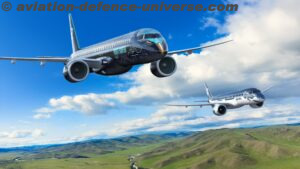In a new report, “Making Net-Zero Aviation possible: An industry-backed, 1.5°C aligned Transition
Strategy”, backed by more than 50 industry leaders, the Mission Possible Partnership (MPP) and the
Clean Skies for Tomorrow Coalition (CST) have released a transition strategy outlining how the aviation
sector can reach net-zero emissions in aviation by 2050.
Endorsed by major global aviation leaders including Airbus, American Airlines, Air France-KLM, and
easyJet, MPP’s Aviation Transition Strategy provides a shared vision for the industry’s low-carbon future,
detailing real economy milestones for not just 2050, but also for the near-term. It outlines, for instance,
that 10–15% of the final jet fuel demand need to come from SAFs (Sustainable Aviation Fuels) by 2030 in order to kick off the transition to net-zero in the 2030s and 2040s – requiring a ramp-up of the current
SAF project pipeline by a factor of 5–6 by 2030.
Global aviation is currently responsible for about 3% of total global, anthropogenic CO 2 emissions –
having seen an increase by over a third between 2010 and 2019 alone. If aviation were unmitigated, it
could be responsible for 22% of global emissions by 2050.
While the current path will see global temperatures rise 2.4°C, this net-zero roadmap would get the
industry back on track to deliver on a 1.5°C target. The report makes clear that immediate action within
this decade is required to set global aviation on a path to climate-neutrality, following three major
milestones: carbon-neutral growth until 2030, halving emissions until 2040, net-zero emissions by 2050.
MAKING AVIATION DECARBONISATION POSSIBLE
The report lays out strategies for the global aviation sector to achieve net-zero emissions by 2050 while
complying with a 1.5°C carbon budget. It highlights what implications this transformation has on the
broader energy system, the airline industry and what capital investments as well as actions from policy
makers will be needed.
- Bringing aviation on a path to net-zero emissions by 2050 requires a doubling of historical fuel efficiency gains of aircraft, a rapid roll-out of Sustainable Aviation Fuels (SAFs) and the market entry of novel propulsion aircraft (i.e., hydrogen, battery-electric or hybrid aircraft) in the mid 2030s.
- Currently, about 0.05–0.10 Mt SAF are produced per year, only a tiny fraction of the global aviation fuel demand of about 320 Mt jet fuel. Also current project pipelines for Sustainable Aviation Fuels (SAFs) production of about 8 Mt are insufficient and need to be scaled up by factor of 5–6 to supply 40–50 Mt SAF by 2030. That SAF volume could require about 300 SAF plants. Until 2050, 300–370 Mt SAF could be required to fulfil the jet fuel demand of a net-zero aviation sector. Hence, current SAF production levels need to increase by a factor of 3,000 7,000 within less than three decades.
- Although average fuel costs are increasing in the net-zero scenario, the cost of flying could remain stable, if the higher costs of SAFs compared with fossil jet fuel are counterbalanced by increased efficiency gains.
- Hydrogen and battery-electric aircraft can make aviation more efficient starting in the 2030s and could potentially supply up to a third of the final energy demand by 2050.
- Average annual investments between 2022 and 2050 to get global aviation to net zero are estimated at about $175 billion 1 (roughly the GDP of a city like Berlin or Amsterdam). 95% of these capital investments would be required for fuel production and upstream assets like renewable electricity generation.
- The roadmap also highlights the implications the transition has on the energy system. By 2050, the aviation sector could demand 5–10% of the expected global renewable electricity demand, 10–30% of the expected global hydrogen demand, up to 25% of the global sustainable biomass, and 600–850 Mt CO 2 captured from the atmosphere.
QUOTES
- Matt
- Additional CEOs
Johan Lundgren, CEO of easyJet, said: “We believe that novel propulsion technologies, including
hydrogen, can offer the most sustainable solution for a short haul airline like easyJet. The adoption of
these technologies will help reduce the climate impact of our operations while preserving the immense
economic and social benefits that aviation brings to the world. We therefore support the Mission
Possible Partnership Aviation Transition Strategy.”
INTERACTIVE TOOL: AVIATION NET-ZERO TRANSITION EXPLORER
The Aviation Net-Zero Transition Explorer [link to the Explorer] is a first-of-a-kind sectoral interactive
tool, providing a visual representation of the key findings of the report. The user can adjust key
technology and cost drivers to create custom decarbonisation scenarios, allowing them to understand
how different levels of technology innovation and climate ambition affect the speed and cost of the
transition.
Decisionmakers from the aviation sector, policymakers and investors can use this open-access tool to
understand the challenges and opportunities of decarbonising aviation and base their policy and
investment decisions on comprehensive modelling of potential future market developments.
MAKING NET-ZERO TRANSPORT POSSIBLE
This report joins a series of sector transition strategies that MPP is developing. Of the seven harder-to-
abate sectors MPP is addressing, three are from the transport sector: aviation, shipping, and trucking.
Together representing almost 10% of global GHG emissions, they share multiple common
characteristics: all have high expected demand growth rates, all require a rapid switch to renewable
energy carriers and all are hard to abate. 1 This compares to additional investments of about 1.5-1.8 trillion per annum required between 2020 and 2050 to build a net-zero-emissions economy by mid-century.
The three sector transition strategies highlight how these sectors can transition to climate neutrality –
not in silos, but orchestrated across all MPP industries. Footed on the same modelling assumptions,
policymakers, and financial institutions can directly compare the findings of all MPP sector transition
strategies. Based on these strategy reports, MPP seeks to kick off real-world projects to translate global
strategy thinking into real action.
Mission Possible Partnership (MPP)
Led by the ETC, RMI, WMBC, and the World Economic Forum, the Mission Possible Partnership (MPP) is an alliance of climate leaders focused on supercharging the decarbonization of seven global industries representing 30% of emissions – aviation, shipping, trucking, steel, aluminium, cement/concrete, and chemicals. Without immediate action, these sectors alone are projected to exceed the world’s remaining 1.5°C carbon budget by 2030. MPP brings together the world’s most influential leaders across finance, policy, industry and business. MPP is focused on activating the entire ecosystem of stakeholders across the entire value chain required to move global industries to net-zero.
Clean Skies for Tomorrow (CST)
The Clean Skies for Tomorrow (CST) coalition provides a crucial global mechanism for top executives and public leaders, across and beyond the aviation value chain, to align on a transition to sustainable aviation fuels as part of a meaningful and proactive pathway for the industry to achieve carbon-neutral flying. The Clean Skies for Tomorrow Coalition is led by the World Economic Forum in collaboration with the RMI and the Energy Transitions Commission.

































































































































